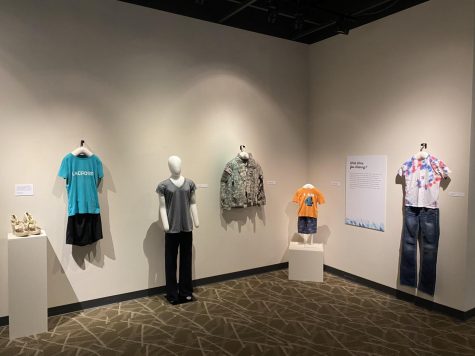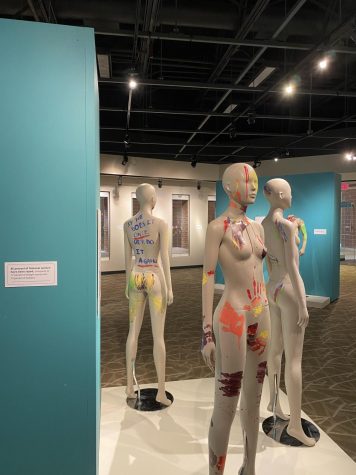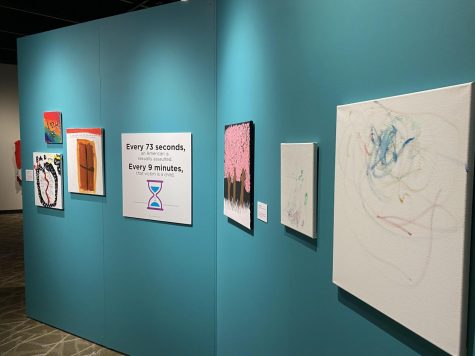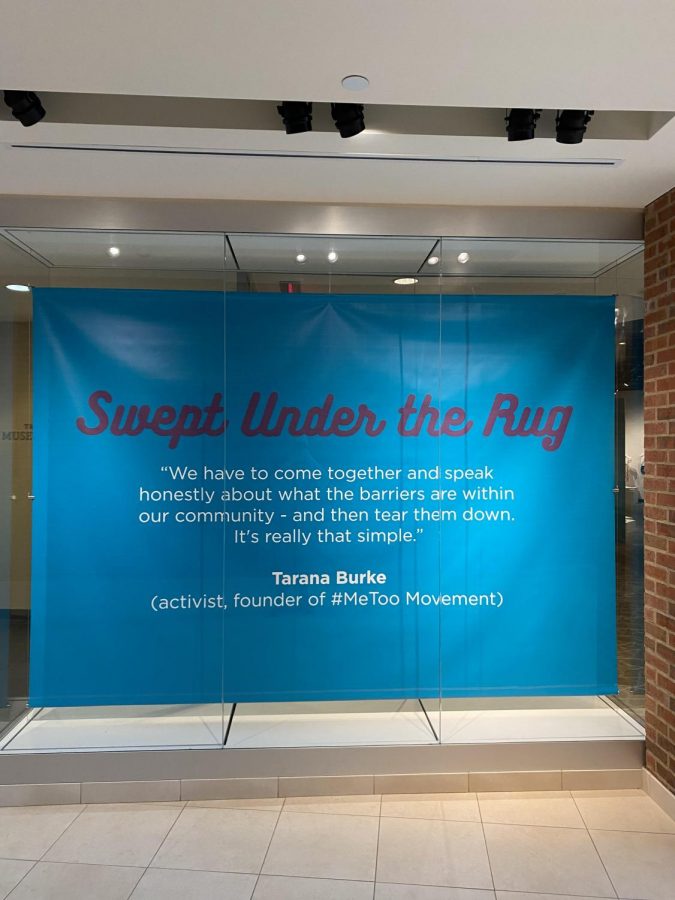Swept Under the Rug shows how imperative it is to spread awareness for sexual violence survivors
Swept Under the Rug exhibit.
September 30, 2020
DeKALB — Safe Passage and the Pick Museum of Anthropology joined together to create a powerful and moving art exhibit, Swept Under the Rug, Sept. 29 through Dec. 4 that showcases sexual and domestic violence through survivors’ art.
The exhibit was broken into three sections, “What Were You Wearing?,” “Touched” and “When a Child Speaks.” Each section deals with a different aspect of sexual and domestic violence through art created by survivors with statistics and facts about the topics at hand.
“What Were You Wearing?”
A common occurrence when a survivor opens up about their experiences with sexual and domestic violence is a question that puts blame upon the victim, and that question is “What were you wearing?”
This section of the exhibit displays articles of clothing from survivors at the time of their assault. Some articles of clothing were accompanied by a small excerpt explaining how old they were when they were assaulted and how old they are now and an occasional description of the assault.
“What Were You Wearing?” is undoubtedly a tough section to progress through. Seeing children’s clothes, a U.S. Army uniform and an NIU Dining Services uniform was demoralizing. It didn’t matter the profession, age or type of clothing. This section proved that anyone is susceptible to cruel acts of sexual and domestic violence.
Reflecting back on this section of the exhibit, an important takeaway explained at the beginning of the exhibit is that everyone should be safe despite what they choose to wear.

“Touched”

The biggest section of the exhibit is “Touched.” Survivors painted on mannequins where they’ve been subjected to negative or non-consensual experiences like abuse and sexual violence that stuck with the survivors for the rest of their lives like a permanent invisible scar.
A key aspect to this section is the color key used on each mannequin. If a survivor used the color green, that means it’s from a family member, orange for someone who made them uncomfortable, purple for someone they didn’t know, blue for a friend, yellow for a partner and red for someone they didn’t consent to.
The most eye opening realization of this section is both the sheer amount of different experiences these survivors had and how many times the color green was used.
Family is a sacred and special bond, and it’s even more terrifying when family members invade another family member’s space in a way that resorts to sexual and domestic violence. An overwhelming majority of the mannequins on display used the color green to signify when a survivor was subject to sexual or domestic violence from a family member. To have so many survivors portray that family — people who you’re supposed to feel safe around — committed these types of acts against other family members, it’s staggering and haunting.
Many of the mannequins did not have just one paint splotch on them. Often each mannequin had more than one paint splotch and that was scary to think about.
“When a child speaks”
“When a Child Speaks” presents facts and statistics behind sexual and domestic violence committed against children with art from children survivors as well. Childhood is often linked with innocence and when that innocence is fractured by sexual and domestic violence at such a young age, that could lead to a lifetime of PTSD and other side effects, according to the Rape, Abuse & Incest National Network.
Most of the art on display did not discuss specific experiences, but demonstrated how children coped with the abuse they experienced by making art as a direct response to their feelings. There’s something about taking in these works of art that makes this section of the exhibit really special. By simply displaying the art by these children who experienced such cruel acts shows a resemblance of hope for them going forward because of the amount of life they have ahead of themselves.

Other takeaways
While this exhibit was broken up into three main sections, there’s still some miscellaneous items that complement the exhibit very well. A big takeaway for the exhibit as a whole is how traumatizing these types of experiences are on the survivor. Many survivors often deal with depression, PTSD and drug abuse, according to the Rape, Abuse & Incest National Network. Considering that, It’s important to keep in mind that everyone is going through something.
An extremely important issue often glanced over is sexual and domestic violence among American Indian and Alaskan Native women. To see something dedicated to spreading awareness about that topic was very encouraging as it’s often tucked aside. Same thing with a section of statistics on how transgender people are more likley to experiance sexual or domestic abuse.
Swept Under the Rug is a must-see exhibit while it’s on display at the Pick Museum of Anthropology. Swept Under the Rug will be on display at the Pick Museum until Dec. 4 and a date and time to visit can be reserved on the event website.
While it does deal with unsettling issues, it’s extremely important to spread awareness and understand these issues so as a society we can fight stereotypes and hopefully create a safe space for everyone. It’s also an immense honor to learn about the experiences of survivors through their art, and that opportunity shouldn’t be taken for granted, as these are deeply personal and traumatizing experiences.
Safe Passage offers free and confidential survivor services available for all genders, ages and sexualites no matter when the abuse occured. Safe Passage can be contacted by phone at 815-756-5228 or by text at 815-393-1995 or at their website 24/7.







